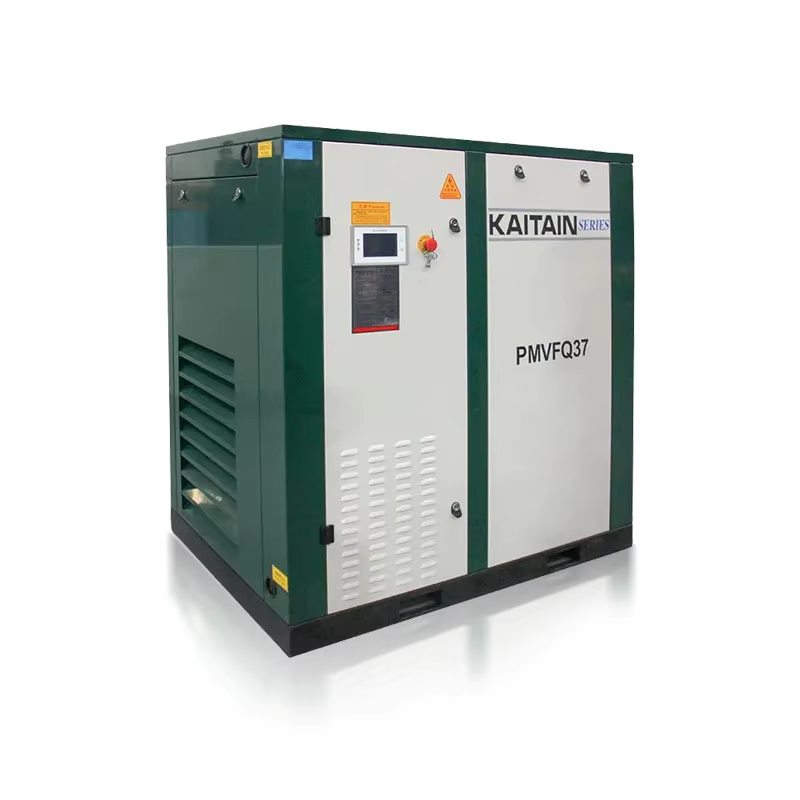Basic Principles of Air Compression
Understanding Kinetic to Potential Energy Conversion
Air compression is fundamentally about converting kinetic energy into potential energy. Kinetic energy, the energy of motion, is harnessed from moving air and turned into potential energy that can be stored and utilized. Air compressors function by capturing the kinetic energy of air molecules, compressing them, and storing them as high-pressure air—essentially converting motion into a storable energy format. This transformation is crucial in powering various tools and devices, making compressors indispensable in settings like workshops and industrial plants. Whether we think of an air compressor machine used in the manufacturing sector or a portable air compressor for roadside emergencies, the science of kinetic to potential energy conversion remains the cornerstone of air compressor technology.
Positive Displacement vs. Dynamic Displacement
Air compressors are categorized into two main types based on their operational mechanisms: positive displacement and dynamic displacement compressors. Positive displacement compressors work by trapping a specific volume of air and reducing its space, thus increasing pressure. This type includes reciprocating compressors, which utilize pistons, and rotary screw compressors, favored for their efficiency and reliability in continuous operation. These compressors are commonly used in industries requiring consistent pressure output, such as manufacturing and automotive services.
Conversely, dynamic displacement compressors, like centrifugal compressors, increase air velocity through a rapid rotating impeller, converting kinetic energy into pressure. This method is ideal for applications demanding large volumes of air at variable pressures, such as in chemical plants and HVAC systems. Industry statistics highlight the prevalence of positive displacement compressors in small to medium-sized enterprises, while dynamic compressors shine in large-scale industrial environments. Understanding these mechanics helps us select the right compressor type tailored to specific operational needs.
For more detailed insights, you can explore options like the Industrial Screw Air Compressor, offering both efficiency and reliability for industrial applications.
Key Components of an Air Compressor Machine
Motor/Engine and Air Intake System
The motor or engine is the powerhouse that drives the air compressor machine, utilizing different power sources such as electricity or gas. Electric motors are widely preferred due to their efficiency and ability to provide consistent power levels, whereas gas engines may be used in areas where electricity is not easily accessible. The air intake system is crucial as it draws ambient air into the compressor, initiating the compression process. It consists of intake valves, filters, and connectors. Effective filtration is essential to protect the compressor's parts from damage caused by dust and other particulates. The efficiency of the motor dramatically influences the overall performance of the air compressor. For instance, a study on power consumption in industrial settings highlighted how a high-efficiency electric motor could significantly reduce operational costs while maintaining performance levels. Through understanding these components, we can appreciate how they contribute to refining the performance of air compressor machines.
Compression Chamber and Storage Tank
The compression chamber plays a fundamental role in air pressure increase within an air compressor, employing various mechanisms like pistons or rotors to achieve this. Reciprocating compressors use pistons to compress air within cylinders, while rotary screw compressors utilize helical screws for continuous operation. The storage tank, often called the air receiver, serves as a reservoir to hold the compressed air until needed. Tank size is crucial for maintaining system efficiency; larger tanks ensure steady pressure during peak demand and help stabilize pressure fluctuations. Data indicated that adequately sized storage tanks could improve pressure stability, ensuring more reliable air delivery in industrial applications. These components synergize to form a critical part of any compressed air system, enhancing its reliability and operational capacity.
Pressure Relief Valves and Gauges
Pressure relief valves are indispensable components in air compressors, ensuring safety by releasing excessive pressure that could otherwise lead to system failures or hazards. They act as a safeguard by maintaining controlled pressure levels and preventing potential accidents. Pressure gauges, on the other hand, provide real-time monitoring of pressure levels, enabling users to maintain optimal system health and performance. Keeping tabs on these pressure levels is vital for adhering to safety standards and maximizing equipment lifespan. Recent industry statistics underscore the importance of pressure relief valves in compliance with regulations, thereby affirming their necessity as integral features in modern air compressor systems. Understanding the role of these devices helps in constructing systems that are both safe and efficient in their operation.
The Step-by-Step Air Compression Process
Air Intake and Filtration
The air intake process in an air compressor is crucial for maintaining the efficiency and longevity of the system. Clean air entry is essential as contaminants can reduce the machine's efficacy and damage internal components. To ensure clean air intake, various filtration methods are employed, including using particulate, coalescing, and activated carbon filters. These filters capture particles, moisture, and impurities, safeguarding the compressor's parts. Effective filtration can significantly reduce maintenance costs. Statistics show that proper filtration can cut operational costs by up to 50% and extend the compressor's lifespan by preventing damage [Journal of Industrial Maintenance, 2020].
Compression Mechanism Variations
Air compressors utilize different compression mechanisms, each offering unique benefits for varied applications. Positive displacement mechanisms like rotary screw and reciprocating piston compressors are commonly used for industrial tasks requiring continuous and robust air flow. For instance, rotary screw compressors are known for their quiet operation and longevity, making them ideal for demanding environments, while reciprocating piston compressors deliver powerful compression suitable for high-pressure applications. Dynamic compressors, like centrifugal ones, are designed for large-scale operations needing high air volume. Research shows that advancements in these technologies have greatly enhanced compressor efficiency, enabling more precise and energy-efficient systems [Journal of Compressor Technology, 2021].
Storage, Cooling, and Discharge
Storage tanks in air compressors play a vital role in maintaining consistent pressure outputs, while efficient cooling systems prevent overheating and extend the equipment's life. Proper discharge systems ensure the smooth release of compress air into the application. Cooling systems are particularly crucial as they reduce thermal stress, thereby enhancing operational efficiency. Studies have shown that efficient cooling can increase the lifespan of compressors by up to 25% [International Journal of Heat and Mass Transfer, 2019]. The discharge process directly influences overall efficiency, making it a key factor in optimizing air compressor performance.
Applications and Benefits of Portable Air Compressors
Construction and Automotive Uses
Portable air compressors are essential in the construction sector, powering various pneumatic tools such as nail guns, jackhammers, and concrete vibrators. These tools amplify productivity by offering mobility benefits, making setups quick and hassle-free compared to stationary units. In the automotive industry, portable air compressors facilitate tire inflation, airbrushing, and other pneumatic tasks with ease and precision. This flexibility makes these compressors a preferred choice over larger, stationary units. Statistics reflect a significant adoption rate of portable air compressors in these industries; for instance, the construction sector reports over 70% of tools relying on portable air compressors for efficient operation. This trend underscores the increasing reliance on mobility and efficiency within industrial workflows.
Energy Efficiency in Small-Scale Operations
The energy efficiency offered by portable air compressors is crucial for small-scale operations. These modern devices incorporate technological advancements that substantially reduce energy consumption, translating to lower operational costs. Innovations, such as improved motor designs and better material quality in manufacturing, enhance compressor efficiency, making them more environmentally friendly and cost-effective. For example, a study showcased a 30% reduction in energy consumption, leading to significant cost savings when businesses implemented newer compressor designs. This evidence highlights the transformative impact of energy-efficient technology within sectors relying on pneumatic solutions, further cementing portable air compressors as an indispensable asset in maintaining sustainable operation dynamics.

